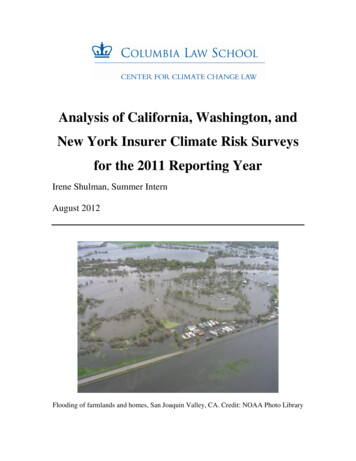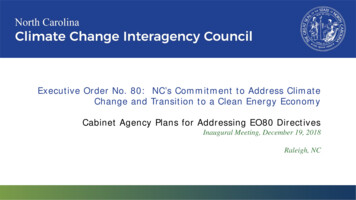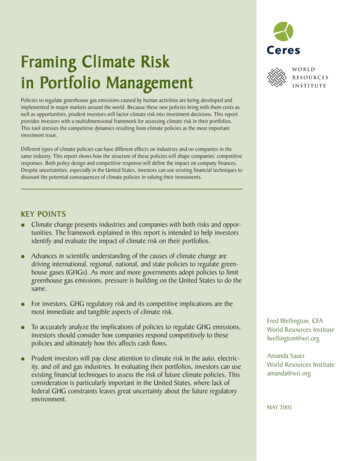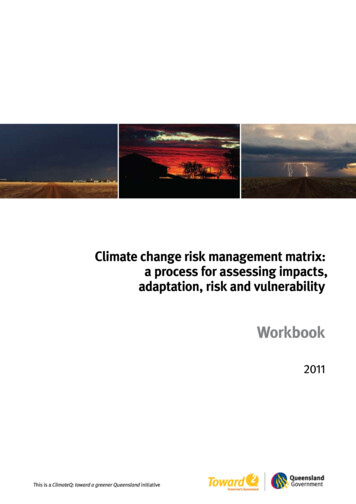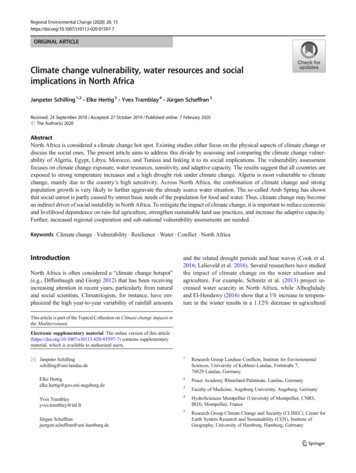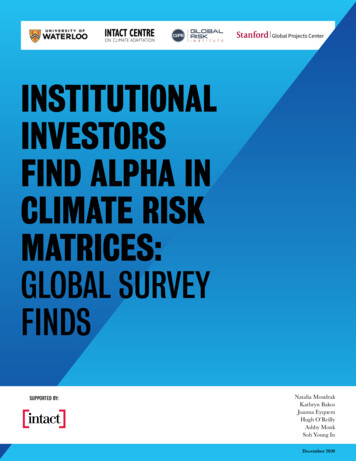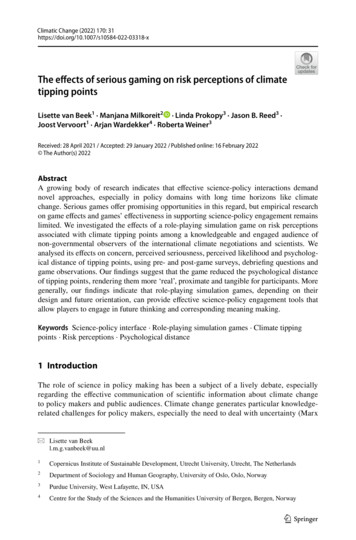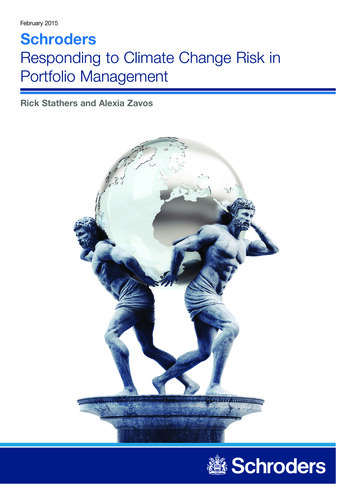
Transcription
February 2015SchrodersResponding to Climate Change Risk inPortfolio ManagementRick Stathers and Alexia Zavos
Responding to Climate Change Risk inPortfolio ssing portfolios’ carbon risksEconomic analysis of the long term impacts of climate change onportfolio investment strategy and returns.04 Analysing portfolios on carbon exposure andcarbon risk managementPortfolio carbon footprint & carbon asset exposure analysisPortfolio constituents climate change risk management analysis06Managing portfolios’ carbon risk exposureCompany stewardship081011DivestmentFossil fuel free exclusion impacts13Appendix 1 –Background information to climate change and the carbon bubble15Appendix 2 –Schroders’ climate change timelineIntegration – stock valuation and selectionHedging
Responding to Climate Change Risk inPortfolio ManagementBackground–– 97% of the world’s climate scientists agree that human emissions of greenhouse gasesare responsible for climate change–– In 2009, governments at the Copenhagen climate talks committed to limiting globalwarming to no more than 2 C above pre-industrial temperatures, beyond this level,scientists threaten catastrophic climate change–– Limiting atmospheric concentrations of CO2 to 450 parts per million (ppm) will give us a50% chance of achieving this target–– Current atmospheric concentrations of CO2 are 395ppm. This means we can only emitaround 570GT of CO2 between now and 2050 to stay within 450ppm–– The carbon embedded in the world’s fossil fuel reserves is around 2,800GT, implying onlya fifth of it can be burnt–– This means that the majority of assets for listed fossil fuel companies can not be burntand (under this scenario) should be recognised as a liability or “stranded assets”.This paper explores the various strategies that investors can employ to understand theirexposure to climate change risks and to mitigate these risks. We list below the topics thatare discussed:Assessing portfolios’ carbon risks–– Economic analysis of long term impacts of climate change on portfolioinvestment strategy–– Analysing portfolio carbon risk exposure–– Portfolio carbon footprint & carbon asset exposure analysis–– Portfolio constituents climate change risk management analysis.Managing portfolios’ carbon risk exposure–– Company stewardship–– Fossil fuel company engagement–– All company engagement on climate change–– Integration into stock selection and valuation–– Hedging–– Divestment.1
2Responding to Climate Change Risk inPortfolio ManagementIntroductionSince the Carbon Tracker Initiative’s first report1, in 2012, which highlighted the concept ofa carbon bubble, there has been a steady increase in the level of interest and activity on theconcept of “stranded assets”. This is demonstrated through activities such as the divestmentcampaign of 350.org, the Bank of England’s formal announcement in 2014 that it willinvestigate the financial risks of a “carbon bubble” and ExxonMobil’s publication of a carbonasset risk report as a result of shareholder pressure. In September 2013 we publisheda paper entitled “Unburnable carbon: How should investors respond?” in which we putforward a series of responses that investors may wish to implement when assessing andmanaging their portfolios’ exposure to climate change and carbon assets.This paper highlights how Schroders can help investors to assess their exposure to climatechange, before identifying some of the options that investors may wish to implement (or haveimplemented on their behalf) in order to manage this exposure. Schroders recognises that inorder to avoid dangerous global warming of 2 C, then the whole global economy will have todecarbonise materially over the next few decades and that all sectors of the economy will beimpacted by this.Assessing portfolios’carbon riskEconomic analysis of the long term impacts of climate change on portfolioinvestment strategy and returns.It was in 2006 that “The Stern Review on The Economics of Climate Change”2 waspublished. This was one of the earliest, and certainly the most discussed, reports onthe economic risks posed by climate change. Stern concluded that, depending onthe range of risks taken into account, climate change could cost the global economybetween 5 to 20% of GDP in perpetuity unless action is taken to mitigate global warming.Since the Stern review it is noticeable that despite the increasing concerns of climatescientists and the publication of two Intergovernmental Panel on Climate Change (IPCC)reports3 on the growing evidence for, and impacts of, climate change there has been aconsummate failure by economists to assess the economic impacts of climate change.Indeed Schroders has undertaken two pieces of research (in 2011 and 2013) to engagewith the Chief Economists of some of the world’s largest investment banks on how theyintegrated an assessment of environmental change into their forecasts and none were ableto demonstrate that they did.Given the potential impacts of climate change, from weather extremes to sea level rise,this raises serious concerns about the validity of long term economic growth forecastsand how these influence investment strategy advice. In addition to raising concerns aboutthe accuracy of GDP growth predictions it also questions assumptions about the value offuture asset stocks (e.g. cities, agricultural land and infrastructure). This was highlighted bythe 2014 report “Risky Business”4 which focussed on the potential costs of climate changeto the US economy. It found that by 2050 between 66 billion to 106 billion of coastalproperty will be likely to be below sea level with a 1-in-20 chance that this increasesto 701 billion by the end of the century; in addition heat extremes will impact labourproductivity and agricultural output across the country (Figure 1 illustrates the increasingincidence of days over 95 F [35 C]. Human beings must maintain a skin temperaturebelow 95 F in order to effectively cool down and avoid heat stroke).1234“Unburnable Carbon – Are the world’s financial markets carrying a carbon bubble?” Carbon tracker Initiative, 2012Nicholas Stern “The Economics of Climate Change. The Stern review”, January 2007IPCC Fifth Assessment Report: Climate Change 2013 & Fourth Assessment Report: Climate Change 2007Risky Business Project “Risky business: A climate risk assessment for the United States” June 2014
Responding to Climate Change Risk inPortfolio ManagementFigure 1: Average days over 95 F: Projections mapped over a lifetimeSource: Risky Business Project “Risky business: A climate risk assessment for the United States” June 2014.The current debate on stranded assets is therefore just one side of the coin. The legitimatecarbon budget arguments put forward by the Carbon Tracker Initiative serve to highlightthe current carbon-economic risk embedded in the valuations of fossil fuel companies (andhence stock exchanges), however what is less well explored is the medium term risk ofstranded assets (e.g. sea level rise and flooded cities, loss of agricultural land, droughtsand their impact on water infrastructure) under business-as-usual scenarios and how thisshould be reflected in current investment strategies. We therefore welcome the fact thatthere is a growing body of activity within this area such as Mercer’s study assessing theinvestment implications of different climate scenarios (the results of which are due to bepublished in March 2015), highlighting a growing awareness by investors of the need tobetter model and understand the medium and long term risks to their investments fromchanges in the biosphere that current models of economic growth are creating.Schroders will:–– Collaborate with other stakeholders to explore this topic in greater depth (Schrodersaccepted a role as an advisor to a project run by the Cambridge Institute for SustainabilityLeadership looking at the environmental risks to investment portfolio value)–– Continue to seek and encourage greater economic analysis of the long-term impacts ofclimate change3
4Responding to Climate Change Risk inPortfolio ManagementAnalysing portfolios oncarbon exposure and carbonrisk managementClimate change, its impacts and the societal response is not just an issue that is peculiar tothe fossil fuel sector. Indeed the latest analysis by the UN highlights the fact that between2055 and 2070 the world’s economy needs to achieve carbon neutrality and that by 2030global emissions will have to be 10% lower than they were in 20105 (In figure 2 the blue areahighlights the steep emission reduction pathway needed to keep within the 2 C carbonbudget compared to predicted emissions pathway under business-as-usual scenarios). Thismeans that there needs to be significant decarbonisation across the entire global economyand the companies and sectors within it.Figure 2: Illustration of carbon dioxide emission budgets in line with limiting warming to 2 CAnnual global total CO2 emissions (Gt CO2/yr)807060504030Cumulative CO2emissions in baselinescenarios from2010 – 2100201001950Remaining2ºC CO2budget20002050Time (years)2100Source: “The Emissions Gap Report 2014” United Nations Environment Programme, November 2014.Portfolio carbon footprint & carbon asset exposure analysisAnalysis of the carbon footprint (e.g. emissions per unit invested) of investors’ portfolioswould enable investors to make an informed assessment about the climate change riskacross their portfolio and to monitor progress in managing this risk over time. Though itis noted that portfolio carbon footprint analysis comes with some caveats such as notmeasuring the emissions from a company’s products (e.g. autos), double counting (e.g.emissions from an electric utility can also be accounted for through another company’selectricity usage) and discrepancies in the data (e.g. not all companies publish theirgreenhouse gas emission data, and collection can vary between companies).In 2014 it was announced that Schroders had successfully won the mandate for themanagement of Friends Life’s Stewardship funds. As part of our pitch for these funds wehad proposed the monitoring of the funds’ carbon footprint together with some long term(2020 and 2025) targets to reduce this footprint relative to its benchmark year of 2015. Inorder to facilitate this we subscribe to the carbon analysis data of MSCI and will be utilisingit in 2015. We were pleased to note other similar developments within the responsibleinvestment (RI) market when later in the year the Montreal Carbon Pledge was announced(in which signatories commit to monitoring their portfolio carbon footprints).Investors can also analyse the exposure of a portfolio to carbon reserves (e.g. reserves ofcoal, oil, gas, oil sands and shale oil).5 United Nations Environment Programme “The emissions gap report 2014: A UNEP Synthesis report” November 2014
Responding to Climate Change Risk inPortfolio ManagementPortfolio constituents climate change risk management analysisIn addition to the capability to monitor the carbon footprint of the portfolio investors canalso analyse how companies, across a portfolio, are managing their carbon footprints.This would predominantly be through the analysis of greenhouse gas emissions dataand reduction targets. Transparency of this information has been the primary goal ofCDP (previously known as the Carbon Disclosure Project), to which Schroders has beena signatory since 2006. Schroders is also a founder member of CDP’s Carbon ActionInitiative in 2011, set up to actively engage with companies in order to encourage theestablishment of publicly disclosed targets and to make annual emissions reductions.Schroders can:–– Analyse a portfolio’s carbon footprint–– Analyse portfolio constituents disclosure on greenhouse gas emissions dataand reduction targets–– Analyse a portfolio’s carbon reserves exposure.5
6Responding to Climate Change Risk inPortfolio ManagementManaging portfolio’s carbonrisk exposureCompany stewardshipInvestors can, and do, actively engage with companies (whether through meetings withmanagement or voting at general meetings) to ensure better stewardship of a company byits management.With regards to the fossil fuel debate investors could question senior management offossil fuel companies on the environmental stress testing that they have used to assessthe long term viability of the business. This should include an assessment of differentclimate change scenarios (e.g. the impacts of different temperature change ranges andthe political responses brought about to achieve these) on the long term viability of thebusiness strategy. Investors could question companies on:–– their assumptions about the political response to climate change–– carbon prices and their use in operational decision making–– the physical impacts of climate change to their business and the wider economy–– and R&D investment in technologies to enhance the longevity of their reserves(e.g. Carbon capture and sequestration).The responses could be used to inform investors views on the risk return profile theyhave of a company and, if they feel this is at odds with their own views of a 2 C strategy(if they have one), they could challenge management on capital allocation plans, and theredistribution of capital back to investors in the form of dividends or share buy-backs.Engagement and voting could also be used to focus on whether directors are incentivised tomaximise shareholder value or whether their incentives focus too much on growth(i.e. increasing reserves).Investors should also engage with the management of companies in other sectors on theirclimate change stress tests to their business model and how they are responding to thefindings. At the minimum we would expect all companies to be monitoring and publishingdata on their greenhouse gas emissions as well as setting targets to reduce these emissions.The need for ambitious target setting was underlined within the Carbon Action Initiatives’20146 report which found that, from its analysis of 224 companies in heavy-emittingindustries, 79% reported emissions-reduction targets in 2014. 43% of companies hadadopted absolute emissions reduction targets but emissions were only reduced by 1% forthe year compared with a required 1.3-1.89% annual reduction (based on IPCC projections).Schroders has had a formal ESG engagement process since 2000, and our first recordof engagement with a company on climate change dates back to 2002. We have beenactive in various collaborative initiatives to raise awareness about the risks of climatechange to the investment case (we were founding members of the Institutional InvestorsGroup on Climate Change) and to encourage greater disclosure on climate change dataand the establishment of greenhouse gas emission reduction targets (through CDP andthe Carbon Action Initiative). We first voted on this issue at a company’s AGM in 2000 andhave subsequently voted on over 170 shareholder resolutions related to climate change(13% of all shareholder resolutions voted on) as of December 31, 2014.Overleaf we provide an example of our long term engagement with BHP Billiton on climatechange related issues. We have been engaging with BHP on its general approach toenvironment, social and governance (ESG) issues since 2002, however our first explicitrecord of engagement with the company on the topic of climate change dates fromQ4 2003.6 CDP “Why companies need emissions reduction targets: the key to a low-carbon economy” November 2014.
Responding to Climate Change Risk inPortfolio ManagementSchroders does:–– support collaborative engagement with companies on climate change issues–– encourage companies to publish greenhouse gas data and set meaningfulreduction targets–– encourage companies to undertake climate change stress testing of their businessmodels under different climate change scenariosTable 1: Schroders long-term engagement with BHP on climate change issuesDate of engagementTopics discussed and outcomesQ4 2003Discussion on BHP’s disclosure of its greenhouse gas (GHG) emissionsQ1 2007Discussion on BHP’s portfolio risk exposure to climate change. BHPresponded that parts of its portfolio (aluminium, carbon steel anduranium) are positively exposed to climate change opportunities suchas light-weighting and nuclear power development. The coal businessis disadvantaged due to declining EU demand, BHP responded bybundling coal sales up with carbon credits.Q2 2011Discussions with the company on emissions trading, efficiencyimprovements and the exposure of its portfolio to climate change risksand opportunities.Q2 2012We asked the company to establish absolute GHG reduction targets(this was met in 2013).Q3 2012We discussed the impacts of the Australian carbon tax on its business.Our conclusion was that because BHP has a sector leading carbonmanagement plan it was less exposed than peers.Q2 2013Discussion on the risks from the physical impacts of climate change tothe business (e.g. mine flooding, logistics disruption). We also discussedthe issue of unburnable carbon and BHP’s view. BHP responded thatthe diversification within its portfolio helped to reduce its exposure to thisissue.Q4 2013Discussion on BHP’s climate change strategy and operational footprint.The company announced that it uses an internal carbon price and fiveclimate change scenarios to inform its investment strategy. We werepleased that the company responded to previous engagement requestsand disclosed its target to reduce and maintain its GHG emissions to2006 levels by 2017.Q2 2014We had a climate change risk update and discussion on portfolioexposure (given recent announcements by BHP on coal). The companyexplained that the five climate change scenarios (using a number ofvariables including GDP, macro issues and policy response) and acarbon price informed board discussions and CAPEX planning. Weasked the company to disclose its climate change scenarios and carbonprice in order to help us integrate an assessment of its climate changerisk management practices within our valuation. We also discussedfugitive GHG emissions from shale operations.Q3 2014The company has disclosed more details on its climate change scenarioanalysis though we are still encouraging it to disclose the carbon price itassumes for its internal modelling.Source: For illustrative purposes only and not to be considered as a recommendation to buy or sell shares of the company.7
8Responding to Climate Change Risk inPortfolio ManagementIntegration –stock valuation and selectionThere are a number of headwinds impacting fossil fuel demand such as regional carbonreduction goals, vehicle fuel efficiency and renewable energy targets, energy efficiencygains and the increasing competitiveness of renewables (2014 renewables investmentbeat expectations despite the falling oil price). This is fused with the structural slowdown inChina and shift to gas in the US. On the supply side, the increasing costs of extraction anddeclining returns on legacy fossil fuel assets means the risks from investing in fossil fuelcompanies at the wrong end of the cost curve have increased. Analysis of 12 global majoroil & gas companies shows that total capital expenditure (CAPEX) over the last nine yearshas increased by 169%, while total production has actually decreased by 2%7.Figure 3: Oil majors CAPEX against energy production rates (2005-2013)Millions27.5Majors’ capex has increased by 169% over the past nine years yet production has 55024.023.520052006200720082009Time (years)Total energy production (Mboe/d) LHS201020112012201300Total capex ( ) RHSSource: Bloomberg, combined for RDSA, BP, FP, ENI, XOM, REP, CVX, BG, STL, HES, PETR, LKOH.The oil price volatility in 2014 highlights the implications of shifts in the oil supply cost curve.For example, oil-sands projects are characterized by low cash costs once they are up andrunning (in the range of 30-40/bbl), but very high upfront capital costs in the developmentphase (requiring breakeven oil prices of 85-105/bbl). 2014 saw the cancellation of threelarge and high-profile new oil-sands projects due to the decline in the oil price. Analysts maywish to link this to broader macro-economics rather than the unburnable carbon debatebut either way, these actions can be used as the basis for engaging others with high costexposure on the economic justification for approving new projects.7 Stranded Assets, Standard Life December 2014.
Responding to Climate Change Risk inPortfolio ManagementFor many analysts the political risk of climate change legislation feels too remote tointegrate climate change scenarios beyond merely factoring in the cost of carbon (wherealready legislated or pending legislation). However the policy implications are already broadand far reaching and there will be significant variations to the impact on companies acrossall sectors. At Schroders our dedicated ESG team sits with the investment teams, enablingregular dialogue on thematic issues and specific stocks. The team produces a numberof detailed research pieces to help support and inform decision making by our analysts.Since, 2003 we have written 36 dedicated pieces on climate change. Some recent reportexamples include:–– Summarizing the IPCC trilogy and its implications for investors (2014)–– A ‘golden age’ of shale or just a pipe dream? (2014)–– Unburnable carbon: How should investors respond? (2013).In 2013 we held a secular market forum on “challenges of avoiding dangerous climatechange and the carbon bubble on the world’s stock markets” which was open to allemployees in order to raise awareness. We also produce a Global Climate ChangeMonthly newsletter for internal and external circulation which keeps analysts up to date onpolicy developments and climate change news.Finally, we have created a global ESG integration analyst tool which helps financial analyststo capture key ESG issues relevant to each sub-industry and an ESG section is embeddedin research templates. These are audited by the ESG team on an annual basis.Schroders does:–– Work to integrate climate change (and ESG issues) into our investment process–– Produce thematic research on climate change issues–– Provide training to investors and the wider workforce on climate change–– Produce regular news letters on developments in climate change science, economicsand policy.9
10Responding to Climate Change Risk inPortfolio ManagementHedgingThere are a number of new financial instruments - hedging tools, indices, new insuranceproducts and climate change funds that investors can use to re-allocate capital and helpthe transition from a fossil fuel dependant economy. For example, investors can invest in aclimate change themed fund to gain exposure to those companies who are beneficiariesfrom efforts to mitigate and adapt to climate change.Alternatively investors may consider tilting their portfolio to better position it for increasingclimate legislation. In 2012 AP4, the Swedish State Pension Fund, became the firstinstitutional investor to hedge the carbon exposure of part of its equity portfolio when itadopted an S&P500 equity strategy that excluded the worst 20% of the index in terms ofcarbon intensity. This carbon efficient index has closely mimicked the S&P500 in performanceterms since then. AP4 and France’s FRR have since committed 1bn to a strategy developedwith Amundi and MSCI. They are optimizing the composition of the low carbon portfolio soas to minimize the tracking error8 with the reference benchmark index. The tracking error isalmost eliminated for a low carbon index that has 50% less carbon footprint.Figure 4: MSCI All Country World Index: Carbon Risk ReductionCurrent CO2 Emissions (Scope 1 2)Future CO2 Emissions (from Reserves)Source: MSCI Global Low carbon Indexes presentation, Dec 2014.In a recent paper, AP4’s CEO and others argue that, “by investing in such an indexGt CO28.0Gt -94%00.0MSCIAll CountryWorld IndexMSCI ACWILow carbontarget indexMSCI ACWILow carbonleaders indexMSCIAll CountryWorld IndexMSCI ACWILow carbontarget indexMSCI ACWILow carbonleaders indexinvestors are holding, in effect, a “free option9 on carbon”: as long as the introduction ofsignificant limits on CO2 emissions is postponed they are essentially able to obtain thesame returns as on a benchmark index, but the day when CO2 emissions are priced thelow carbon index should outperform the benchmark.10”Schroders has:–– A fund which invests in companies that will benefit from efforts to mitigate or adapt toclimate change–– The capacity to recommend third party funds for private clients and charities to accesssustainable thematics such as energy efficiency and companies offering climatechange solutions.8The tracking error is a measure of how closely a portfolio follows the index to which it is benchmarked.9An option is a contract that gives the buyer the right, but not the obligation, to buy or sell an underlying asset at acertain price, on or before a certain date.10 Hedging Climate Risk by Mats Andersson, Patrick Bolton and Frederic Samama 22nd September 2014.
11Responding to Climate Change Risk inPortfolio ManagementDivestmentThe divestment campaign has gathered pace since it began in 2013 and, according to theUS Fossil Free Campaign, 50bn has been divested so far11. There have been a range ofcommitments made by high profile organisations. The Rockefeller family announced theyare directing their 860m charitable fund to divest from its coal and tar sand assets “asquickly as possible”. Stanford University announced their plan to divest from coal in May2014 and the University of Glasgow, has announced their decision to divest from the fossilfuel extraction industry over 10 years. Storebrand is selling companies with the highestexposure to coal and oil sands and the Hesta Superfund is restricting new investments inthermal coal companies. Harvard University’s refusal to withdraw their endowment fromfossil fuels has frustrated campaigners and resulted in a law suit being brought by sevenHarvard students. The lawsuit argues that their continued investment in fossil fuels is anabdication of its responsibilities to current and future generations of students.As we can see from these recent announcements, there are many different divestmentinterpretations; ranging from excluding whole fossil fuel sectors such as oil and gas, thedirtiest fossil fuels (e.g. coal and oil sands) or certain activities such as oil sands or Arcticexploration. Depending on the approach taken, excluding fossil fuels will change thebalance of a portfolio, increasing exposure to other sectors and slightly changing the riskreturn parameters.A fossil free portfolio benchmark needs to reflect the approach taken to defining fossil fuelexposure. Leading index providers have responded by introducing fossil fuel free and coalfree indices as well as low carbon indices to help guide investors. FTSE launched its fossilfree index in April 2014. It excludes the companies that explore, own and directly extractcarbon reserves.Figure 5: FTSE Developed Fossil Fuel Index performance vs FTSE DevelopedIndexReturn %Volatility %3m6m12m3yr5yr1yr3yr5yrFTSE Developed ex Fossil Fuels2.10.66.662.271.68.711.714.0FTSE Developed0.9-1.35.155.965.48.811.914.4Past performance is not a guide to future performance and may not be repeated. Thevalue of investments and the income from them may go down as well as up and investorsmay not get back the amounts originally invested. Exchange rate changes may cause thevalue of any overseas investments to rise or fall.Source: FTSE as at 31st December 2014. Based on FTSE Developed vs. FTSE Developed ex-Fossil Fuels. Index designed incollaboration with the Natural Resources Defence Council. Index launched 29th April 2014. Past Performance is not a guideto future performance and may not be repeated.11 The Guardian, ‘Glasgow becomes first university in Europe to divest from fossil fuels’ 08.10.14.
12Responding to Climate Change Risk inPortfolio ManagementFossil fuel free exclusion impacts–– Global: 78 companies, or circa 6.4% of FTSE All-World Developed Index–– UK: 12 companies, or circa 18.6% of the FTSE All-Share Index–– 60% of the excluded stocks in the integrated oil and gas sector – 77% of which areconcentrated in the US and UK markets–– On a global basis, the USA, Canadian and Australian markets are the most affected.1998MSCI has also launched fossil fuel free and carbon free indexes. The ex-coal index resultsin 26 companies being excluded which is just over 1% of the MSCI ACWI though thisresults in a 50% reduction in carbon reserves exposure.Fossil fuel divestment alone may not be the answer, the listed universe of fossil fuelcompanies represents less than a quarter of the world’s known reserves of fossil fuels12with the majority being managed by sovereign owned companies. Fossil fuels are systemicand divesting of fossil fuel extraction companies would still leave portfolio exposure tohigh fossil fuel consuming companies such as utilities, chemicals and aviation. Howeverthere is no doubt that the current level of interest in the economics of fossil fuels signals astructural shift in energy procurement and usage in the next couple of decades. Many ofthose engaged in the debate are the consumers, voters and leaders of the future and so itis likely the divestment campaign will only gain momentum.Schroder’s has been running assets with ethical restrictions applied for more than 15 yearsand 10% of our assets under management (AUM) have a restriction applied. 87% of theseAUM with restrictions outperformed their benchmark over three years, gross of fees to31 July 2014 (Schroders internal research). The Friends Life Stewardship Mandate hasspecific criteria related to fossil fuels and restricts coal, oil sands, oil operations and Arcticexploration at different reven
Portfolio Management Rick Stathers and Alexia Zavos. Contents 01 Background 02 Introduction 02 Assessing portfolios' carbon risks Economic analysis of the long term impacts of climate change on portfolio investment strategy and returns. 04 Analysing portfolios on carbon exposure and carbon risk management Portfolio carbon footprint & carbon asset exposure analysis Portfolio constituents .

